The introduction of embedded SIM (eSIM) technology marks a significant shift in the telecommunication landscape, offering a new level of flexibility and convenience for iPhone users. As we delve into the intricacies of eSIM, we will explore its advantages, potential drawbacks, and how it reshapes the way we think about mobile connectivity.
Table of Contents
What is eSIM?
At its core, an eSIM is a digital SIM that allows users to activate a cellular plan from their carrier without needing a physical nano-SIM. Embedded directly into the device, eSIM technology simplifies the process of switching carriers and managing multiple accounts, making it an attractive feature for iPhone users who value convenience and efficiency.
Why Would I Want to Use eSIM?
The allure of eSIM technology lies in its ability to streamline the user experience. With eSIM, iPhone users can easily switch between carriers or plans, manage multiple lines on a single device, and enjoy seamless connectivity when traveling internationally. This level of flexibility is particularly appealing for individuals who frequently change networks or require multiple numbers for personal and business use.
When Should I Install eSIM?
Opting for eSIM installation is a strategic decision that depends on your specific needs. It’s particularly beneficial when purchasing a new iPhone or when you’re about to travel. eSIM enables you to add a local data plan when abroad, avoiding exorbitant roaming charges. Additionally, if you juggle multiple numbers, eSIM allows for smoother management of these lines, consolidating them into a single device.
How Do I Activate eSIM in iPhone?
Activating an eSIM on your iPhone is a straightforward process. Typically, it involves scanning a QR code provided by your carrier, which contains all the necessary details for setup. Apple’s support website offers a comprehensive guide to this process, ensuring a hassle-free experience for users looking to make the switch to eSIM.
Can I Make Phone Calls with eSIM?
One of the primary functions of eSIM technology is to maintain the core capabilities of a traditional SIM, including making and receiving phone calls. With an eSIM, your iPhone can handle calls, texts, and data, just as it would with a physical SIM card. This feature ensures that users do not compromise on functionality when transitioning to the more flexible eSIM format.
Does eSIM Give You a Phone Number?
Yes, activating an eSIM assigns a phone number to your device, similar to a traditional SIM card. This number is used for calls, SMS, and data services, providing a seamless communication experience. Carriers manage these numbers, and the activation process involves selecting a plan that best suits your needs.
Is It Good to Use eSIM on iPhone?
Using eSIM on an iPhone offers numerous benefits, including enhanced flexibility, easier management of multiple numbers, and a more streamlined device setup process. For users who travel frequently or require multiple phone lines, eSIM technology is particularly advantageous, eliminating the need for physical SIM swaps and simplifying account management.
Is eSIM Good or Bad for iPhone?
While eSIM technology brings many benefits, it’s essential to consider potential drawbacks. One concern is the dependency on carrier support; not all networks offer eSIM services, which could limit your options. Additionally, transferring an eSIM from one device to another can be more complex than simply moving a physical SIM card. However, for many users, the advantages of eSIM, such as improved convenience and flexibility, outweigh these potential limitations.
What is the Disadvantage of eSIM?
One notable disadvantage of eSIM technology is its reliance on carrier support. If your carrier does not support eSIM, or if you travel to a region where eSIM providers are scarce, you might find yourself at a disadvantage. Additionally, eSIM makes it slightly more cumbersome to switch devices, as the transfer process involves more than just moving a physical SIM card.
Does eSIM Drain Battery?
Concerns about eSIM technology impacting battery life stem from the notion that maintaining a digital SIM alongside other device functions could exert additional strain on the battery. However, real-world usage suggests that any impact on battery life is minimal. The efficiency of modern smartphones, coupled with the optimized design of eSIM technology, ensures that battery performance remains robust.
Is It Worth Switching to eSIM?
The decision to switch to eSIM technology hinges on individual needs and preferences. For users who value convenience, the ability to switch carriers easily, and the need to manage multiple lines, eSIM offers a compelling solution. Despite potential limitations such as carrier support and device compatibility, the benefits of eSIM—such as enhanced flexibility and ease of use—make it an attractive option for many iPhone users.
How Do I Reactivate My eSIM on My iPhone?
Reactivating your eSIM involves a similar process to the initial activation. If you’ve switched devices or need to re-enable your eSIM for any reason, you can typically do so through your carrier’s eSIM management portal or by contacting their customer support. Detailed instructions are often available on carriers’ websites, ensuring a smooth reactivation process.
In addition to understanding how eSIM technology works, it’s essential to explore the best eSIM packages available for seamless connectivity. Check out our recommendations for The 5 Best eSIM Packages for Japan, Mexico, France, Italy, Europe, Spain and the UK to ensure you’re equipped with the right plan for your iPhone.
In conclusion, eSIM technology represents a significant evolution in how we connect our devices, offering a blend of convenience, flexibility, and efficiency. For iPhone users, the transition to eSIM can simplify the management of cellular plans and enhance the overall device experience. While there are considerations to keep in mind, such as carrier support and potential impacts on device switching, the benefits of eSIM are compelling for many users. As the technology continues to mature and gain wider adoption, it’s likely that eSIM will become the standard for mobile connectivity, further simplifying our digital lives.


